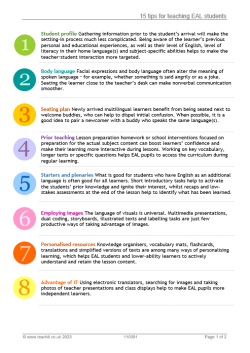15 tips for teaching EAL students

These tips for teaching EAL learners were written by Anna Czebiolko, head of EAL in a mainstream secondary school.
The ideas outlined here will help you to support KS3–KS5 students who speak English as an additional language, whether they are new arrivals with very little English, are in the early stages of English language acquisition or are bilingual/multilingual learners with a high level of English language proficiency. The teaching tips are suitable for English language learners with any home language(s) and include advice on setting up seating plans, personalising resources and providing feedback that helps to further EAL students’ language development.
The tips are based on Anna’s CPD article Integrating EAL support into mainstream teaching.
An extract from the teaching tips:
-
Vocabulary Matching words to pictures and finding definitions or synonyms can be the first steps in absorbing basic Tier 1 words. Writing definitions and practising the use of Tier 2 vocabulary (academic language) is helpful for all learners. Similarly, explicit learning of Tier 3 vocabulary (disciplinary literacy) can benefit the whole class.
-
Reading Highlighting key vocabulary in the text, colour-coding key concepts, and answering true/false or multiple-choice questions on the text are some methods that help multilingual learners to access complex curricular texts.
-
Writing Sentence starters, gap-fill tasks, storyboards, describing pictures, table-fill activities and scaffolded texts develop students’ individual text creation skills. Using personalised writing strategies ensures EAL students can make constructive progress within lesson time.
